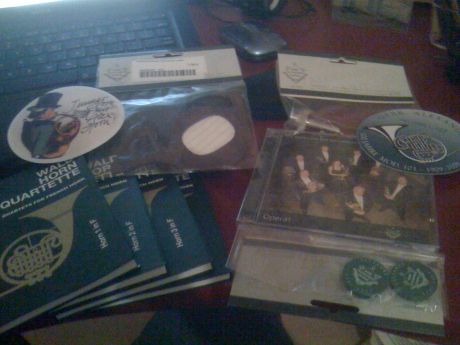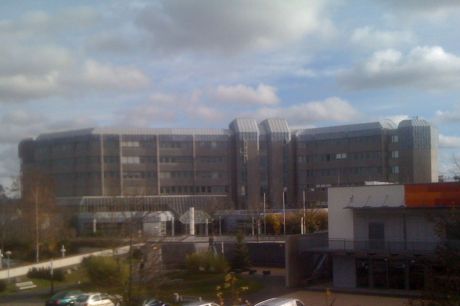When bookstore stockers don’t know their history…
14 December 2009
If you search long enough, eventually you will find exactly what you are looking for…
10 December 2009
…and that can be any number of things, but for me, it was concrete evidence that people linked to the West German government were telling refugees to go home. Not indirectly (I’ve seen enough of that), but straight up.
Then today, in a letter from the leader of the “Association for the Victims of Stalinism” to the Federal Minister for all-German Questions: Im Zusammenhang mit dem von uns bereits früher Vorgetragenem möchten wir noch folgendes mitteilen: In den 8 Wochen unserer Organisations-Arbeit haben wir einige 100 Menschen aus der Ostzone, die sich teilweise schon in Berlin um ihre Anerkennung als politischer Flüchtling bemühten, durch Kameradschaftliche Beeinflussung dazu gebracht, wieder in die Heimat zurückzukehren.
Loosely translated into English (I’m really sorry about the stacked modifiers – that’s probably the hardest thing about translating German): “Together with what we have already told you, we’d like to share the following: In the eight weeks since our organization has begun its work, through friendly influence we have convinced 100 people who were already in Berlin to be recognized as political refugees to instead return to their homes.”
And it’s not like they’re doing this surreptitiously! They’re bragging about it in a letter to one of West Germany’s most powerful politicians, the chair of the party in power, and a political refugee himself (he had been leader of the eastern branch of the conservatives before getting kicked out by the communists). This, along with that good amount of circumstantial evidence, should be enough to make a good case.
That’s it – I might as well just come home now.
German beer of, oh, the past month or so
7 December 2009
So I’ve also been bad at updating this feature, but that’s been partly due to the case of Dom Kölsch I’ve been working through since the beginning of November (good news, I won’t have to go on a serious Kölsch bender the day before I leave, so long as I average two beers every three days the rest of my stay).
I did want to get to this one, though, because it’s the first thing I’m making when (someday) I have a lagering setup. Now, imagine a beer with the malt profile of a really good stout, but without all of the stout downsides (mostly the sense that someone just served you a bread smoothie). Add in the light hop flavor and yeast characteristics of a Pilsner (because it uses a similar variety of hops and comes from roughly the same region)
I give you schwarzbier:
Yes, that’s a lager, with a good thick head and a body so dark that you could watch solar eclipses through it (amazingly, it has a pretty significant refractive value). I had two of these when my mom and I were at the hotel bar her last evening in Germany, and picked up another when I got back to Bonn for the picture. It’s a characteristic style from Saxony, in Eastern Germany (one of the reasons it hasn’t really hit the import scene), but I get the sense that it’s really starting to be picked up a lot of places over here (Köstritzer is probably the biggest brewer, of maybe a half dozen that get some distribution).
Now, doing a little bit of research, I did discover that Sam Adams Black Lager (which I do like) is supposed to be a schwarzbier, but that doesn’t even come close on body. I’m not kidding about the stout thing.
I blame everything on archive fatigue…
7 December 2009
…well, that and a mild but irritating sinus infection that I picked up last week (definitely a sinus infection, and not archive crud, like I had a couple months ago).
I’m not sure whether to be in awe of, or worried by, the sorts of researchers who spend months on end in the archives. I’ve been at this just over three months now, and for the last month, I’ve only been going in three days a week (two if I’ve had visitors); I’m having a hard time being excited even about the exciting new stuff I’m finding (that is, when I’m not coming across copies of the same material over and over and over again). Two stories to illustrate the previous two points. On the former, I’ve established beyond any reasonable doubt just how involved the West German government was involved in funding research on refugees in the 1950s – now, this is essentially an open secret (one guy got himself elected general secretary of a scholarly society because he claimed at the annual meeting that he could bring in the government grants and balance the budget), but it’s the tightness of the network that’s really impressive, and I’m linking it to all sorts of other people. Now, that’s really exciting, and I’m glad that I’ve been going through countless binders full of the same files from different offices to get it.
I’m also learning a lot about individual (though, unfortunately, nameless) bureaucrats and their personal levels of organization. Now, these are the Germans we’re talking about here, but there’s still a pretty wide gap. Looking at three binders today on the same research group, from three different offices in the same ministry. Guy number one is the sort who just keeps tossing files into a box, no attempt at organization, but when I get to it, it’s in roughly reverse chronological order (most recent on top, oldest on the bottom), but with a few things out of order and a bunch of extra copies that sometimes get tossed in with notes on them.
Guy number two, no real sense of organization. Files from 1954, 1957, 1952, another copy of that file from ’57, unreadable handwritten notes, two copies of files from 1953, and so on. Someone clearly didn’t have the interests of this historian at heart.
Third guy, one copy of everything, in order front to back (which means he took the time to organize his files).
My only regret: that’s the order I read them in, so by the time I got to the third guy, I was totally burned out on “Research Group: Integration” files (and had seen everything at least two or three times). At least it helped to get my chronology straight.
“Is it heaven?” “Nein, es ist Mainz!”
21 November 2009
On my way to pick up my Mom in Frankfurt, I stopped at the Alexander shop in Mainz. Alexander, of course, make the best horns in the world, and the horn room (above) where new purchasers can try out a selection before taking home their favorite (kind of like the horn pound) is, in a way, the center of my personal horn universe. Oh yeah, they have plenty of other horns lying around and hanging on walls in other rooms, too:
What a beautiful sight. Someday (maybe after my first best-selling history book), I will come back to Mainz for the sole purpose of buying a new horn (or just to get my old one repaired and aged…still have no idea just how old it is). Personally, as a hornist and gadget-lover, I like this one:
It’s a bit hard to see around the glass, but that has 7 (7!) valves! I know, most people think we’re insufferable enough with only four valves, but this descant horn (Bb/F alto) not only has switch, drop and stop valves, but it also has a on/off compensating valve, which switches the third (main) valve from 1.5 steps down to 1 step up. And even at the crappy current €/$ exchange rate, it only costs $700 per valve! What value!
Or there’s always a plain old, boring triple horn:
Helps you play high and builds up your biceps!
Of course, it’s hard to leave without a decent amount of Alex stuff, but I sort of managed it (some things below are actually useful!)
Clockwise from top right: a hose attachment that fits in an Alex leadpipe for pressure cleaning (I’m so excited to get home to my horn and basement washtub right now); Alex 103 sticker (free with purchases); CD by the Alex-playing Berlin Phil horn section, strangely NOT for sale at the Berlin Philharmonie, but available in Mainz (completely awesome); Alex magnets (no, they still won’t stick to brass…stupid ferromagnetism); Really cool vinyl-bound set of horn quartet standards (while I’m still three horns short of a quartet, it’s a nice thing to keep in the music bag); another Alex sticker; leather, horn-shaped luggage tag with Alex marque (do I put it on my horn case, or would that be too obvious with the Mainz patch that’s already there?)
The sun sometimes shines in the Rhineland…
20 November 2009
The Bundesarchiv Koblenz in the sunlight (a rare occurrence lately, as we’ve only had a couple non-rainy days this month, and there are only about 9 hours of sunlight a day this far north).
I know, I know, it’s been a while, but research at the BA Koblenz really takes it out of you. First, there’s the sheer hassle of getting there: 1 train per hour from Bad Godesburg, 40 minutes on that (and each round trip is €15.40), then you can either climb the hill (about 80 meters straight up) or pay the ridiculously expensive bus fare (€2.40 before reductions for about a km ride, 30 cents more than a subway trip ANYWHERE within the city of Berlin).
Once you get to the archive (much like NARA in College Park) you’re faced with a dishearteningly long list of relevant files, often found with the help of a nice fachreferant, that you know you don’t have nearly enough time to work through. Still, you have to start somewhere, and if you’re disciplined enough to stay in the reading room (not difficult when it’s raining and barely above freezing) you can work through several boxes of files in a day.
After Berlin, I’ve reverted to my old National Archives practices of scanning files quickly, taking whatever notes may be necessary, and requesting a lot of copies. The nice thing is, they will scan everything I request and send me a CD when I’m back in the US. Yes, there is a cost for this, but it’s already rolled into the steep copying costs of €3 per file to start, and 39 cents per page after that. At least some of it’s in English, so I could potentially use it in a class someday (if I ever teach the Berlin Wall seminar again).
One of the things that still amazes me about researching a period after the invention of mechanized (or at least easy) document copying – and this is still before the age of Xerox, mind you – is the sheer volume of identical documents out there. I have now found the same memos in three different archives (Berlin, Hannover, Koblenz), and I have no doubt that if I were to go to Wiesbaden, Düsseldorf or Munich (other state-level archives) I would find even more copies. But even that’s nothing compared to the files that have 2, 3, 4, or 20 copies of the same document. I looked at one file where about 25% was a single set of copies of a Protokoll, an account of a meeting transcribed for sharing with other departments. I’m guessing that some poor secretary ran all of these through the mimeograph, collated them, and instead of sending them around, put them somewhere safe (like a filing cabinet). Then, 20 years later, they were duly noted as important historical documents and trucked to Koblenz. Thank god the Germans seem to have relied a bit less on carbon paper than the Americans did – there’s nothing in this world worse than trying to read a document that was clearly the fourth sheet of onion skin in a stack of four.
Cloudy with a slight chance of internet access…
8 November 2009
Well, that was an eventful week, mostly because Abby and Andrea were visiting, but also because I didn’t have internet access in my apartment in Bonn until Thursday evening, and then we spent most of the past three days out of the apartment in Köln and Frankfurt. Since I know that people are anxiously awaiting my next update, here’s the condensed version of the week:
Sunday, I left Berlin…
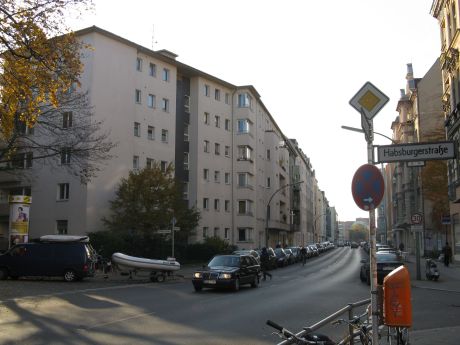
I packed just about everything I own (at least in a living-in-Germany sense) into the only four bags I own (again, for the purposes of this exercise, we aren’t counting the 60 boxes of books and everything else in that full-size moving van last June). Regardless, they’re pretty well stuffed…
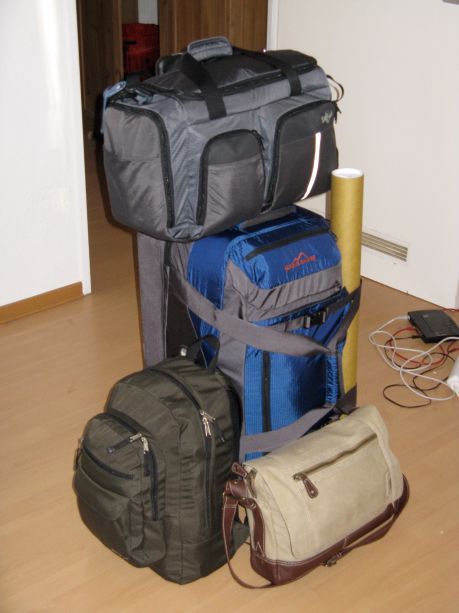
Then I moved across Germany to Bonn, only falling out of one railway car (hauling 50 kg of stuff can get awkward) and had barely settled into my apartment in Bad Godesberg when I had to go pick up Abby at the Frankfurt airport. Andrea arrived the next day (while I was enjoying my first day at the Bundesarchiv in Koblenz) and for the rest of the week they had a vacation, while I mixed days off with days on. Unfortunately, it rained just about every day they were here (November in Germany…what can I say).
Day off (drinking Kölsch in Köln):
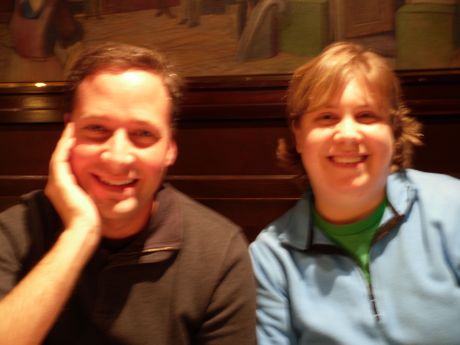
Then I dropped both of them off at Frankfurt Airport, and took the train back up the Rhine to my apartment…
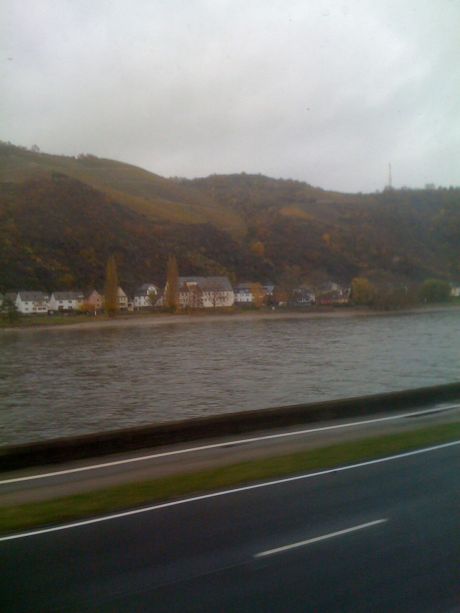
This is also the route I take every morning to Koblenz now (well, not exactly – the picture was taken south of Koblenz), but I do get a lot of Rhine views from the top level of my regional express. More on that later, since I have to get back to grading my online course (having visitors really threw off my schedule…in a good way, of course).
…but I finally got my first German haircut.

Have I had better haircuts? Yes. Cheaper? At €10, not since the $5 ‘110 Special’ at the Court Street Regis in Athens. Will I be seeing David the day after I get home in December? Definitely. At least it’s out of my ears (and be glad I don’t have a ‘before’ picture of the back of my neck…)
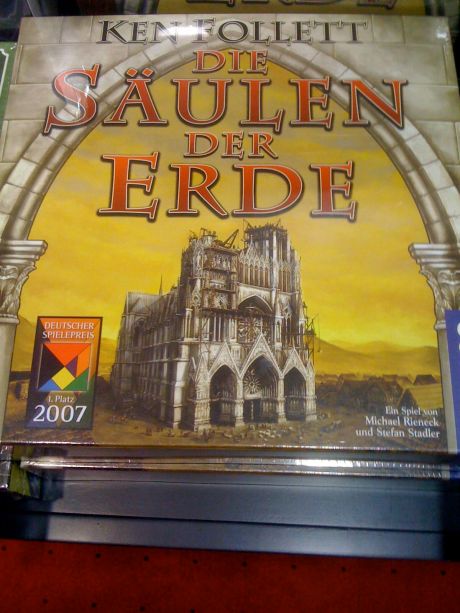
Yes, it’s a board game based on The Pillars of the Earth (one of my all-time favorites, and at least partly to blame for the four years of my life spent studying medieval history). Strategy-type card/board games like this are really big business in Germany (think Settlers of Catan, another game I’d love to play if I could find people to play it with), and the fact that this one won the 2007 Spielerpreis (actually kinda prestigious) means that it’s probably pretty good. Unfortunately, of course, it’s in German, which probably means that it would eventually occupy the space underneath the CSI board game on our shelf (as in, played even less).
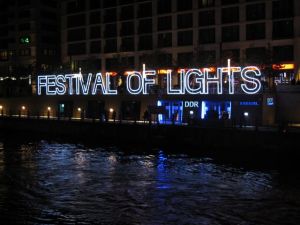
Finally, an evening where it’s not cold and rainy (in fact, just cold), and I can go out and see all of the buildings lit up for the annual Festival of Lights in Berlin. Yep, they don’t even bother to translate it into German – no idea why. There’s stuff all over the city, but tonight I just walked down the main street in the central district, Unter den Linden. Mostly, it gave me a chance to mess with the various manual exposure times and aperture settings on our Canon point-and-shoot.
Started off at Pariser Platz, with the Brandenburger Tor:
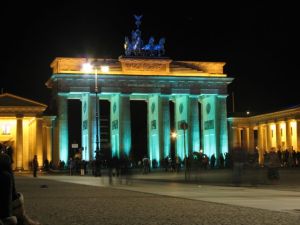
Unfortunately, the only tripod I had was a mini Gorillapod, so almost all of these pictures were taken from bench level, where I could keep the camera steady. Even so, as long as random people didn’t wander in front of me too much, most of the pictures turned out decently.
On Unter Den Linden, the linden trees were all lit up in different colors, too:
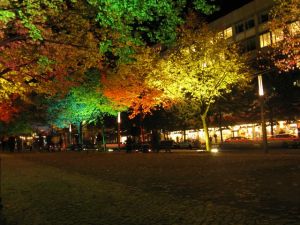
I even took a few looking straight up from the benches:

At the other end, the cathedral had this really cool projected-pattern thing going on, but it was really hard to photograph. I messed around with settings for a good ten minutes before I finally got something decent and decided to move on (the benches around there are all stone, and really cold):
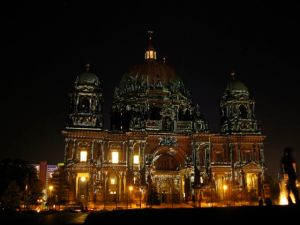
That probably would have been even cooler if they’d turned off those lights in the second floor windows…
Finally, I got a ton of pictures of the TV tower in different colors with my gorillapod wrapped around a railing 30 feet above the river Spree (thankfully, the camera didn’t fall in)…
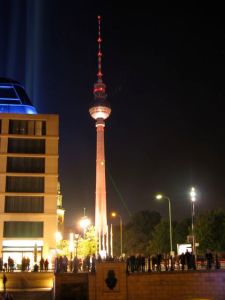
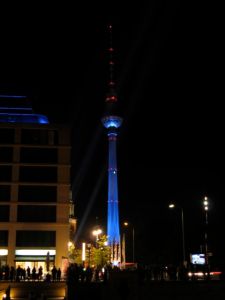
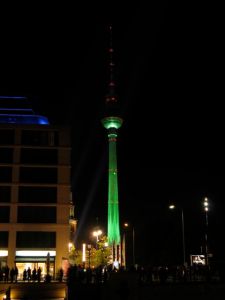
That’s all, now back to work.






